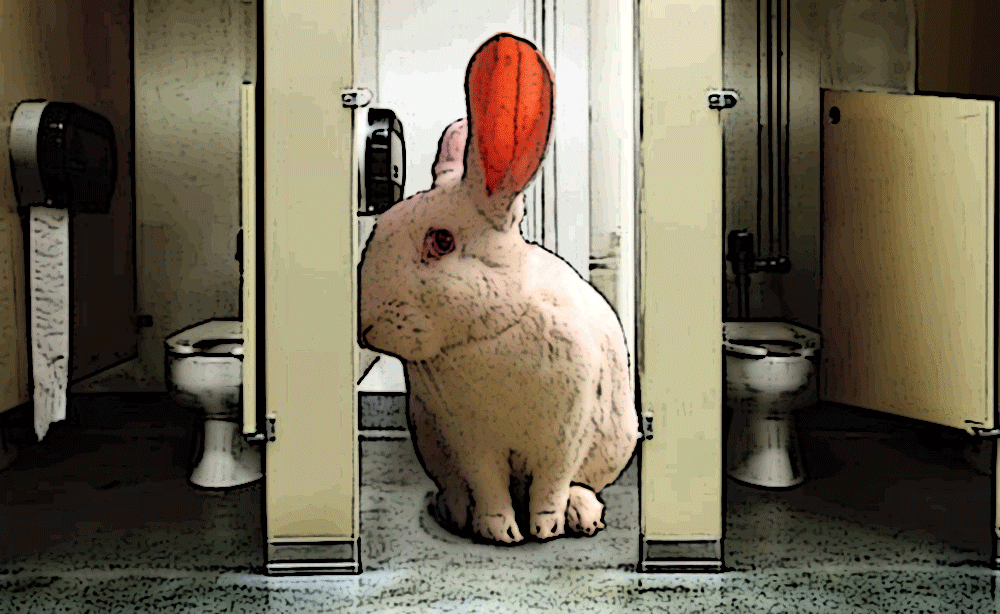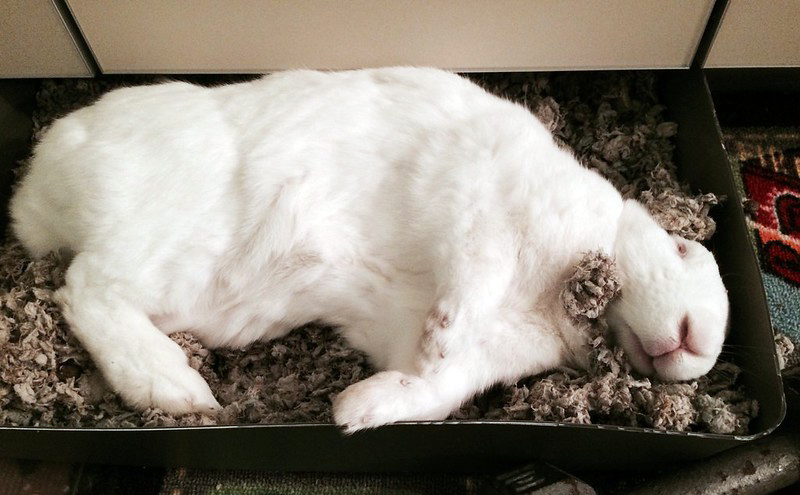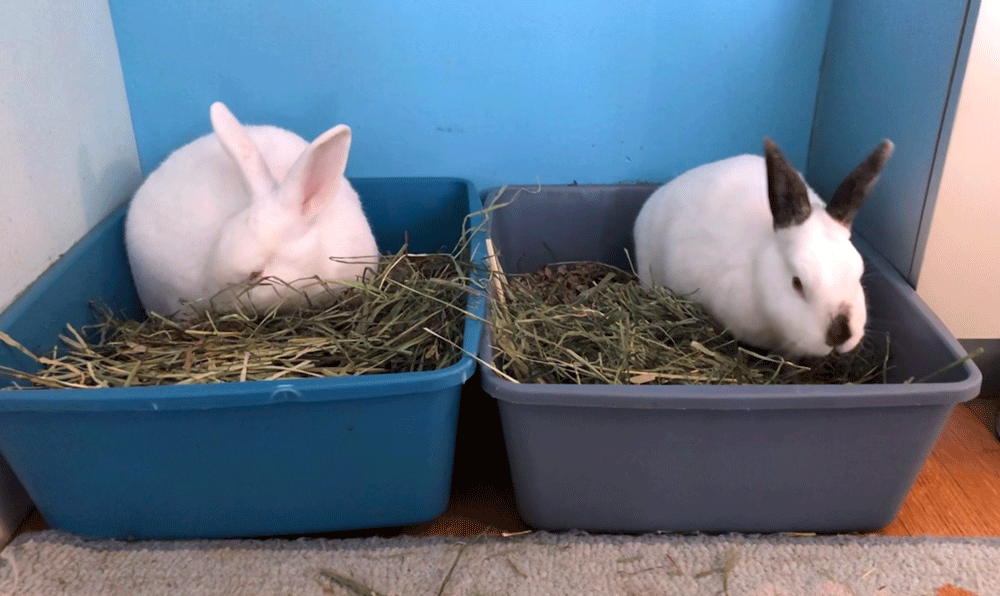
Every rabbit adopter knows the deal: You fall in love with a graceful, adorable, wide-eyed, bundle of silken fur and bring him home. Then he hops onto your living room rug, and unveils his alter-ego: a 24/7 poop factory! Whether you’re just starting out or old friends, here’s the scoop on managing the poop.
Day 1
To start your relationship out on the right paw, choose a low-traffic corner location and outfit it with a litter box. Sequester your new friend in this area upon his arrival for a few hours (a 36 or 40″ tall exercise pen should do the trick) — long enough for him to adopt the box as his toilet. Unless you’re very unlucky, your bun will emerge litter-trained.
How to enhance the chances of this outcome? Make the box the best it can be.
Location, Location, Location.
A corner location is critical, and not only because of the low-traffic aspect. Walls are another part of the appeal. Bunnies don’t want anybody creeping up behind them while they’re doing their business. For them, the security that corners provide has the utmost lavatory allure. If you don’t choose a corner, they probably will.
What’s Inside the Box
Litter
Every good litter box starts with an absorbent and preferably odor-controlling litter. There are several kinds. I use a wood pulp-based one, but sawdust and other materials can also work well. You need to be careful with ones made of oats or alfalfa because they could become more sought after than supper, causing weight and bloating issues. If you want to try one, just keep careful watch. If it’s becoming the main course, switch to something else.
Some litters are not safe for rabbits. Pine, cedar and clay types are hazardous to the lungs. Corn and wheat-based and clumping litters cause health problems when eaten. I recommend the litter list provided by the House Rabbit Society for more details on do’s and don’ts.
How much to use? Start by putting a single layer that covers the bottom of the pan, maybe a bit thicker at the back. You can adjust the amount over time as you see what works best for you and your bun.
Hay
You’ve probably heard the expression “Don’t [poop] where you eat,”. That’s rock solid advice for humans, but rabbits aren’t people, people. I say, put the hay in the box. No need to make a prissy fuss about it; your rabbit certainly isn’t going to. For her, grazing and pooping are two parts of one fluid motion and she’ll do them simultaneously. I often see people buying special hay feeder trays to hang next to the box or over it. That’s an option but it really isn’t necessary. To keep your life simple, just put the hay in the box.
That said, I will take the trouble to place the hay in the front part of the box, farthest away from the back and corners where the most peeing happens. Buns will sift through a pile of hay looking for their favorite bits, and some of it will travel towards the back as they do. Starting it off at the front will help keep the freshest parts clean until your bun has a chance to pick them over.
Size Matters

Make sure you choose a bin that gives your lil’ buddy ample space to do his thing. Don’t make it the rabbit equivalent of those pint-size powder rooms on airplanes – make it the cousin of the one you see in the Sunday Style Magazine – so going there is a luxury and a pleasure.
While we’re at it, lots of bunnies have another weird washroom habit: hanging out. Yes, some fluff-tails really like to lounge in the box. Don’t be concerned if you see this — it’s not a problem. We found that our boy Monty really enjoyed having an extra box next to the business box just for this purpose.
Housekeeping
Most bun experts agree with this simple cleaning process:
- dump out all the ick
- spray with white vinegar (soak if stains have built up)
- wipe clean
Why white vinegar? It provides the right amount of anti-bacterial cleaning power without any potential harm from fumes or lingering traces that your rabbit could be exposed to.
How often you clean depends on the type of litter you use: some are more absorbent, odor-controlling, and antibacterial than others. If you have a really high-end litter you’ll have to do it less often but I would make sure it’s done at least once a week no matter what. For lesser litters, 2-3 times a week. For something like newspaper you’re best off doing it every day.
If you find that your rabbit roommate stops using the box after the first day or two, he’s probably fussier than you are. You may need to change it more often to keep him happy with it.
The More, The Merrier
The more buns you have, the more boxes you may need. As a spouse who has been waiting her turn in a one-bath condo for 12 years, let me tell you, the single thing I want most in my next home is a second bathroom. Don’t make your bunny buds crowd in the can! Make sure there’s ample space for everyone when they want it.
Our long-ears’ lavatory has a his-and-hers side-by-side setup, though “his” is usually whatever one she’s currently in. Crushed against the side, Moraea will persist for a minute or two, eyeing Finnegan impatiently in the vain hope he’ll clear out, but he never does. The option to hop over to the other bin for some breathing room helps keep the peace in Litter Box Land.

Along the same lines, if you find there’s a second locale that your fluffball gravitates to for bathroom sessions, it’s probably going to be a lot easier to put a box there than to try to make him stop going there. He may be telling you that he too wants a second powder room! Luckily, most buns will naturally prefer out-of-the way places, so why be stingy? Additional litter pans provide more opportunities for bathroom success.
 The Fluffy Tail of This Blog Post
The Fluffy Tail of This Blog Post
Toilet triumph can be achieved by providing ample boxes with safe litter and hay co-mingled. Cleaning them regularly keeps them healthy and non-fragrant. You and your long-eared love can work out an arrangement and cleaning schedule that you’re both comfortable with. So long as you keep it rabbit-safe and healthy, and ensure plenty of hay is available, the rest of the restroom details are negotiable.
Veronica Reed says:
Great writing! Wish I knew this when we had bunnies.
Melinda says:
I have had much tutelage over the past few decades…!
Syl says:
Very interesting!! And more complicated than a bunny novice would expect!
Melinda says:
It’s pretty easy once you get the hang of it.
Mandy says:
Love this post! Excellent insight and truly enjoyed the way you write – we’re new bunny owners so this is great help!
Melinda says:
Thanks so much, Mandy! I’m glad it helped. Best of luck with your bunny/ies. How many do you have?